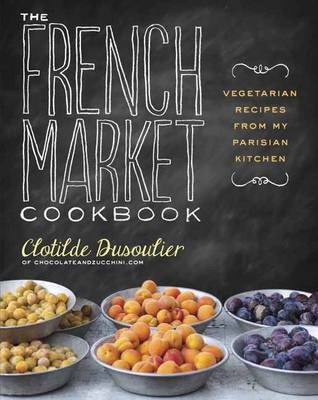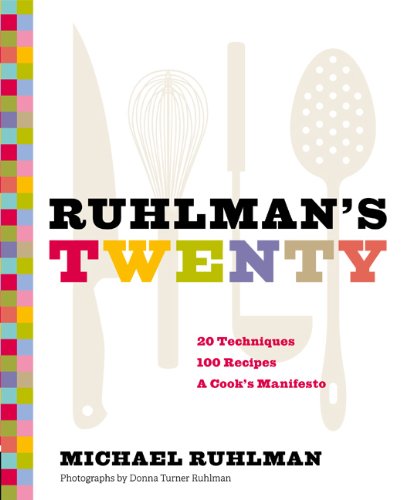Just how long should a recipe be?
June 25, 2013 by SusieFor some years I’ve been an advocate of more explicit recipes – you know, recipes that tell you not just time and temperature (“3-5 minutes over a medium flame”), but what to look, listen, smell, and taste for – the telltale blistering of the skin, the moment when the spice releases its aromatic oils, the squeaking sound the dough makes when it’s absorbed just enough liquid.
But there are a lot of other factors involved in recipe design and construction. The pressure to condense is pretty clear: designers need to meet a particular page count, marketing and sales wants a nice-looking, uncrowded format, and everybody wants there to be room for a picture. The pressure to expand comes from authors and editorial: an urge to explain and foolproof, to charm in the headnotes and to enlighten in the sidebars.
What are some of the tricks publishers use to save space? Here’s a few:
 Nested recipes:
Open up Clotilde Dusoulier’s The French Market Cookbook to the recipe
for “Strawberry Tartlets with Breton Shortbread Crust” and you’ll
see 4 ingredients. Easy, right? But 2 of them – “Lemon
Pastry Cream” and “Breton Shortbread Tart Dough” are separate
recipes you’ll need to go elsewhere in the book for. Is it
worth it to enjoy the spacious 2-page layout here, with the picture
on one side and a brief recipe on the other, but have to hunt
through the book to get the other steps? Or would you rather
have a less compact but possibly more practical 4-page spread? [To
be fair, most of the recipes in this book don’t make use of nesting
– I just happened to open up to this one.]
Nested recipes:
Open up Clotilde Dusoulier’s The French Market Cookbook to the recipe
for “Strawberry Tartlets with Breton Shortbread Crust” and you’ll
see 4 ingredients. Easy, right? But 2 of them – “Lemon
Pastry Cream” and “Breton Shortbread Tart Dough” are separate
recipes you’ll need to go elsewhere in the book for. Is it
worth it to enjoy the spacious 2-page layout here, with the picture
on one side and a brief recipe on the other, but have to hunt
through the book to get the other steps? Or would you rather
have a less compact but possibly more practical 4-page spread? [To
be fair, most of the recipes in this book don’t make use of nesting
– I just happened to open up to this one.]
 Process photos.
In some books, like Ruhlman’s Twenty and The Pioneer Woman Cooks (which otherwise have
little in common), step-by-step photos strike a compromise, letting
each picture shoulder some of the explanatory burden and reducing
the word count (though maybe not by as much as 1000 words a
picture!)
Process photos.
In some books, like Ruhlman’s Twenty and The Pioneer Woman Cooks (which otherwise have
little in common), step-by-step photos strike a compromise, letting
each picture shoulder some of the explanatory burden and reducing
the word count (though maybe not by as much as 1000 words a
picture!)
Narrative format or action format. “Standard format” recipes are the ones we all know: ingredients list, followed by instructions. But narrative format and action format save space by calling out the ingredients within the text. (In action format, the ingredients are called out with bullet points after the first part of the sentence, as in “In a large bowl, toss together: …” In narrative format, the ingredients might be called out in the middle of the sentence – it’s just a difference in syntax.) The best-known example is probably The Joy of Cooking.
Many of these issues disappear in e-cookbooks and recipe apps, thanks to the magic of hyperlinking. Yet paper still gives you physical benefits in the very physical act of cooking.
Personally , I like best of all a two or three-page recipe with a picture, lots of sensory cues, and maybe an anecdote in the headnote or a sidebar with tips. I don’t mind turning the page back and forth to check the ingredients. I get a little impatient with cutesy digressions within the recipe (“I toss the scraps to my adorable schnauzer Lestrade, and he goes wild over them!”) but I generally like catching glimpses of the author’s personality in the language.
Do you prefer your recipes condensed and telegraphic? Or do you like them spelled out? Do you have a subconcious recipe page-limit beyond which you will not go? (I think mine’s 4.) Or are you suspicious of short recipes? I’m curious to know whether there’s a consensus on what’s the ideal length of recipe, or whether it’s varies widely and subjectively…
Categories
- All Posts (6940)
- Antipasto (2135)
- Author Articles (247)
- Book News (935)
- Cookbook Giveaways (983)
- Cookbook Lovers (257)
- Cooking Tips (109)
- Culinary News (299)
- Food Biz People (552)
- Food Online (791)
- Holidays & Celebrations (272)
- New Cookbooks (149)
- Recipes (1500)
- Shelf Life With Susie (231)
- What's New on EYB (133)
Archives
Latest Comments
- Atroyer7 on Danube Cookbook Review and Giveaway
- demomcook on What foods do you look forward to the most for each season?
- demomcook on Danube Cookbook Review and Giveaway
- Darcie on How cookbooks can help build resilience
- mholson3 on Danube Cookbook Review and Giveaway
- Rinshin on How cookbooks can help build resilience
- sarahawker on Danube Cookbook Review and Giveaway
- Sand9 on Danube Cookbook Review and Giveaway
- hankintoby29 on Heritage Cookies of the Mediterranean World – Cookbook Giveaway
- WBB613 on Feasts of Good Fortune Cookbook Giveaway